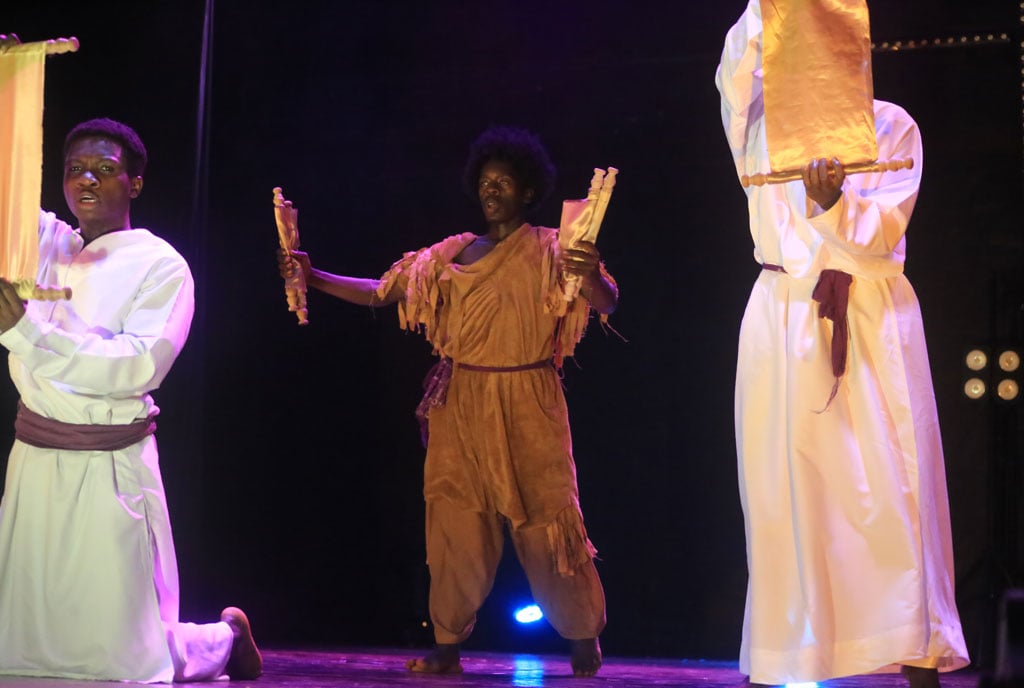The dance, according to John the Baptist

A scene from The Levite, the dance according to John the Baptist. PHOTO/ANDREW KAGGWA
What you need to know:
- Unlike many contemporary shows that rely only on foreign music, this one had a fair mix of both foreign and local.
Breakdance, b-boy, hip hop or street dancing—these are not the kinds of elements one would easily associate with the gospel or anything religious on any day.
Yet the dance theatre show The Levite is exactly about that, a character from the New Testament, John the Baptist.
The dance theatre show that premiered at the National Theatre on Saturday brings to light the story of John the Baptist, his life, and his trials in ministry.
None of this is spoken, though; much of the act, if not all, is a dance routine, which is not hard to understand, especially if you have prior knowledge of the story.
But the Levite is not only about John the Baptist; in fact, the first act is not necessarily about the man but more about these dancers showing off what they are made off. They open the show with Kanye West’s Selah, the second song off his all gospel 2019 album Jesus is King.
During the performance, the dancers using energetic movements, which combine both street and hiphop rooted dances, seem to thank God for changing the course of their lives, which is in sync with Kanye West’s lyrics in the song.
But the actual show only starts later, when they start the story of John the Baptist. This starts with a cage on stage; inside it, we meet our John the Baptist portrayed by Josh Jasper, also one of the show producers.
In a recorded prologue, John talks about his purpose and the need for people to repent and give up their sinful ways; his words seem to have remorse and regret, though he is satisfied with the work he has done.
It was John’s final day before his killing. The story then takes us back to the beginning, with John’s mother and father meeting and later having their son. From both parents, Zechariah his father and Elisabeth his mother, John was a Levite. He was from Aaron’s lineage, yet not one acknowledgement is made regarding John having any ties at all with the already-installed system of Temple worship.
We learn that Levites are priests, and yet John chose a ministry-driven method of preaching about Christ. Though, through the dance, we also get to appreciate why it was important for John, a Levite, to be in the position he found himself in as a baptist. In older days, Kings had been anointed by Levites; thus, in baptising Jesus, Christ was being anointed by the Father with the Holy Spirit through the instrumental action of the Levite, John the Baptist.
The show becomes intense when they tackle John’s turbulent times, with him crossing paths with Herodias, who had just married King Herod and was his brother’s ex-wife.
John criticises the marriage, asking them to respect the scripture. Tired of John’s criticism, when Herodias daughter performs for the king and he likes the performance, he asks her to ask for anything as a reward. Through her mother, she asks for John’s head.
These were the most intense scenes of the production, thanks to the carefulness with which most of them were executed and the difference in the moves, some to show aggression and others intended to symbolise regret.
For instance, like in the Bible, King Herod’s dance moves were more of a worried man who was not in control of the situation. Where his soldiers thumped their chests and stomped the ground with an aura like they were in control, he did slides most of the time and used a number of hand gestures.
It is said that King Herod did not want to kill John, but the situation was out of his hands.
The dance show wins on many fronts, such as production design, costume, and choice of music. Unlike many contemporary shows that rely only on foreign music, this one had a fair mix of both foreign and local. Besides that, the first show had an exaggerated use of the smoke effect; it was intended to create a foggy atmosphere but somehow overdid it. It became impossible to see the dancers on stage at times.




